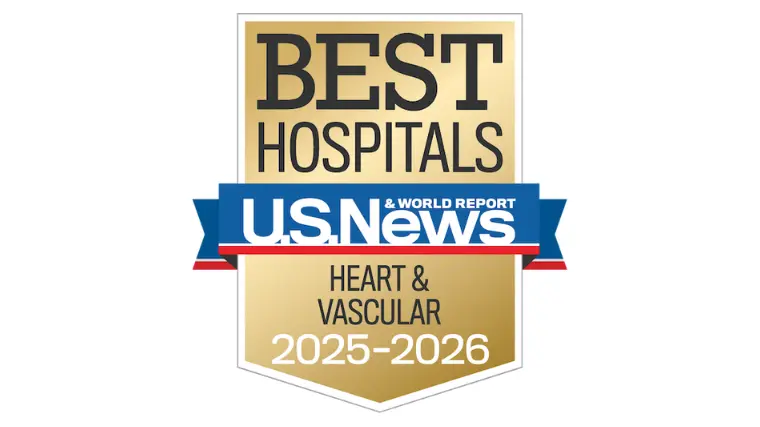Congenital Heart Disease Conditions
Congenital heart defects are complex in adult patients. Congenital defects, such as valve malformations or holes, can further damage or weaken the heart, which makes adult CHD patients susceptible to developing severe heart disease. Cardiology experts at the University of Chicago Medicine can help identify your congenital heart condition(s) and work with you to determine which treatment(s) will be best for your unique needs.
An atrial septal defect (ASD) is a congenital condition where a hole has formed in the wall of tissue that separates the right and left atria (upper chambers of the heart). ASDs cause oxygen-rich blood to mix with oxygen-poor blood, which allows oxygen-poor blood to be delivered to vital organs. Large ASDs can eventually lead to pulmonary hypertension or heart failure, and surgery is typically required to repair the defect.
Types of ASDs:
- Ostium secundum is the most common ASD, and it occurs when a portion of the atrial septum fails to develop normally. This defect can most often be closed using a minimally invasive transcatheter procedure.
- Ostium primum is is a deficiency in part of the atrioventricular canal and is associated with a split (cleft) in the mitral valve.
- Sinus venosus is classified as a hole between the superior vena cava (main vein that is returning blood from the upper body) and the right atrium (right upper chamber of the heart).
- Coronary sinus is the rarest ASD. This is characterized by a hole the coronary sinus, a major vein in the heart.
When a patient is born with mitral valve defects, they are at risk for developing valve disease, including mitral stenosis and mitral regurgitation because the valve function is compromised.
Types of mitral valve disease
- Mitral stenosis occurs when the valve flaps stiffen or fuse together, making the valve opening smaller and narrower, ultimately decreasing blood flow.
- Mitral regurgitation, also know as mitral insufficiency, occurs when the leaflets, or cusps, of the mitral valve do not close properly, allowing blood to flow backwards through the heart.
Hypoplastic left heart syndrome (HLHS) is a birth defect that occurs when the left side of the heart if underdeveloped, with can lead to:
- Left ventricle is too small
- Mitral valve is too small
- Aortic valve is too small
- Ascending aorta is underdeveloped
- Hole between the left and right atrium
The ductus arteriosus is an opening in the heart that typically closed soon after birth. Patients with patent ductus arteriosus (PDA) have a persistent hole between the aorta and pulmonary arteries – two crucial vessels pumping blood from the heart.
Those with a small patent ductus arteriosus should not require any treatment, but if a larger patent ductus arteriosus remains untreated, patients will have blood flow insufficiency and risk further heart damage.
The tetralogy of fallot is a combination of four separate problems that can occur in the heart, impacting blood flows from the heart to the body:
- A hole in the lower chambers
- The aorta obstructs the hole
- The muscle around the lower chamber thickens
- Blockage from the heart to the lungs
Stenosis is characterized by a narrowing of the valve due to plaque build-up (atherosclerosis). When the valve thickens or narrows, the opening becomes smaller and blood cannot pass through the valve as easily. With stenosis, the heart works hard to compensate for the constricted opening and blood flow is reduced to other chambers of the heart and/or to vital organs. In severe cases, heart valve surgery or interventional procedures may be necessary to prevent serious health complications. Patients can be diagnosed with:
- Mitral valve stenosis
- Aortic valve stenosis
- Tricuspid valve stenosis
- Pulmonary valve stenosis
A ventricular septal defect (VSD) is an opening in the intraventricular septum, the wall between the left and right ventricles (lower chambers of the heart). VSDs can be congenital or develop later in life after experiencing a heart attack. The hole allows blood from the left ventricle to flow back into the right ventricle and can lead to low blood pressure, low oxygen content and even heart failure.
Types of VSD
- Perimembranous is an opening in the upper section of the septum and is most commonly repaired through open-heart surgery.
- Muscular is the most common type of VSD. Muscular VSD can close spontaneously without intervention or and can be treated using an interventional transcatheter procedure.
- Conal Septal is the rarest VSD and can be found below the pulmonic valve.
- Infarct-Related VSD occurs when a portion of the heart is being deprived of blood, such as during a heart attack. When the heart experiencing prolonged deprivation, heart tissue may begin to die and develop a hole in what previously normally functioning heart tissue.
Conditions and comorbidities associated with congenital heart disease
Because ACHD often requires the heart to work harder to overcome any defects, adult congenital heart disease patients are at risk of developing serious conditions that can exacerbate any preexisting conditions or can create additional strain on the heart and lungs. Common comorbidities associated with congenital heart disease include:
Contact Us
For general questions about our adult congenital heart disease (ACHD) program, please contact us at 773-702-7777.
Nationally Ranked in Cardiology, Heart Surgery and Vascular Surgery

Request an Appointment
We are currently experiencing a high volume of inquiries, leading to delayed response times. For faster assistance, please call 1-773-702-9461 to schedule your appointment.
If you have symptoms of an urgent nature, please call your doctor or go to the emergency room immediately.
You can also request an online second opinion from our specialists
* Indicates required field
